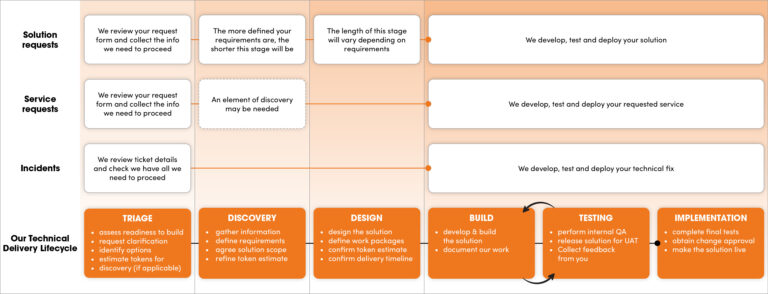Stage 5: Testing – ensuring your solution works and will deliver value
This is the fifth of our deep–dive articles, walking our customers through our new Technical Delivery Lifecycle approach, which we’ll implement in early 2024. If you haven’t already, please read the introductory article, which will give you an overview of our approach and what happens leading up to the Testing stage.
What does Testing involve, and when does it start?
We’ll be ready to put it through a rigorous testing process once we’ve finished creating your solution in the Build stage.

Testing isn’t purely about ensuring the solution works – we’ll also want to verify that it fulfils all your requirements to be sure it will deliver enhanced value for your business.
There are two critical parts to testing:
- Internal quality assurance (or QA)
This is the work we’ll do ourselves to ensure the solution is working properly on a technical level. Here, we’ll focus on the quality of our technical work and will only hand it over to you once we’re satisfied everything is functioning correctly.
- User acceptance testing (or UAT)
This is where you test the solution in your organisation’s ‘real world’ environment to check whether it’s working as you expect it to.
How do we ensure the solution is working as you envisaged?
From the perspective of your organisation, UAT can sometimes be time-consuming and require a lot of internal coordination. For example, you will need to ask colleagues to give up some of their time to put the solution through its paces – which can be challenging if they’re busy or wary of adapting to a new system.
We recognise that this can sometimes be difficult, but it’s also essential. Therefore, at an earlier stage, we’ll already have agreed with you on a milestone date for starting UAT. This will give you plenty of time to prepare and avoid unnecessary delays – for example, by scheduling it well ahead with all the right people and allowing you to explain the importance of UAT.
What if there are any problems at this stage?
The purpose of UAT is to ensure the solution fully meets the requirements we’ve previously agreed.
We’ll give you clear guidance on how to carry out UAT and the best way to articulate any feedback you need to provide us with. In particular, we’ll help ensure your input is linked to one or more of the agreed requirements.
Once we’ve received your feedback, we’ll apply any required changes – reverting to our Design and Build process if necessary – and check again to ensure everything works correctly.
Finally, when UAT has been completed and you’re fully satisfied with the solution, we can move on to the last stage in our Lifecycle approach: Implementation.
Do you know how you can find out more?
We’ll shortly publish our article about Implementation, explaining the final stage in the Lifecycle approach. (Watch out for an email landing in your inbox to tell you when it’s live.)
Before we launch our Lifecycle approach, you can be sure that we’ll meet with you to explain the changes and give you the opportunity to ask any questions.
But if you’d like to discuss this with us in the meantime and get a clearer understanding of how it will help to deliver even greater value for your organisation, please don’t hesitate to contact us.



